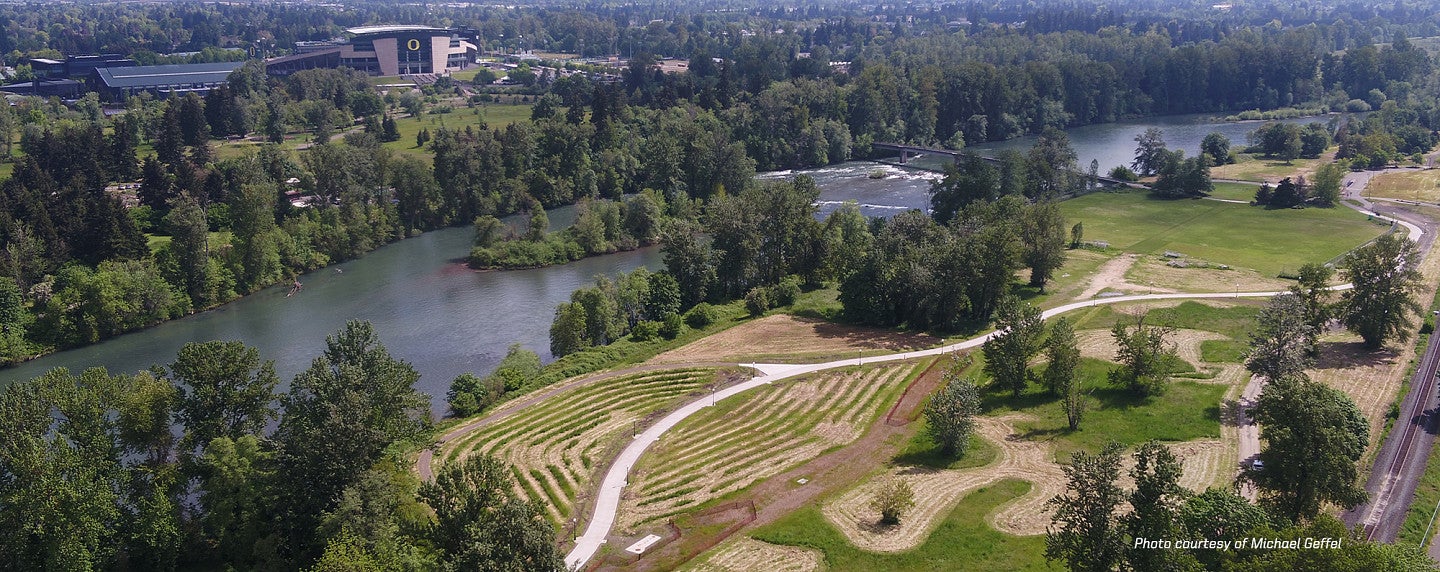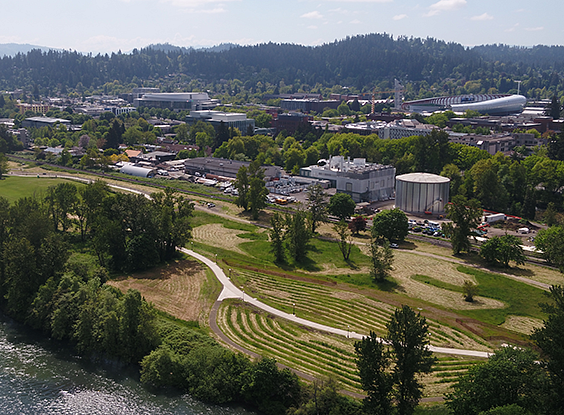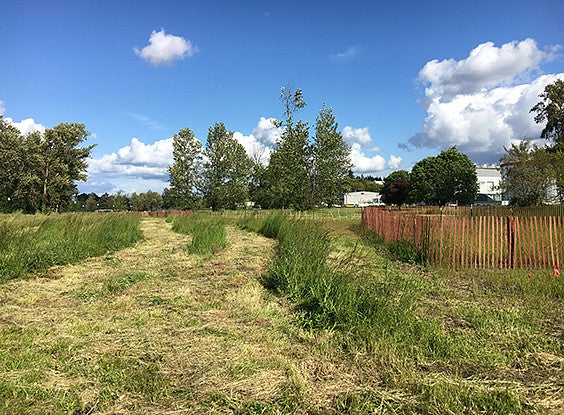
A landscape architecture professor is using a riverside meadow as a testing ground with multiple goals in mind
Folks who use the riverbank path system near the Frohnmayer Footbridge will notice a much more pleasant scene than in previous years as they pass through what is in fact a large laboratory — known as the Fuller Land Lab.
Previously, the sprawling field between the railroad tracks and the South Bank Path was essentially unused and mowed to the ground twice a year: once to slow blackberry bushes’ spread and then to minimize fire risk.
But now walkers, runners and cyclists traversing this stretch of the path will get to enjoy a meadow of carefully managed grassland punctuated with wildflowers thanks to research-in-progress by College of Design landscape architecture professor Michael Geffel, his team of students and a host of campus collaborators.

And they have more in store for the multitudes of people who will use the path going between World Athletics Championships Oregon22 events at Hayward Field and the fan festival at the recently completed Downtown Riverfront Park.
But beautifying the land is only one benefit of Geffel’s research.
“What I'm looking at is how we can adjust our maintenance operations to work on landscapes that maybe don't have the budget for a wholescale restoration or the mini-landscapes that are maintained for easements, along highways,” he said. “Those are of interest to me because there's actually a ton of land that's treated this way.
“I'm not trying to make more work for anyone or make more maintenance,” he added. “I am actually just trying to minimize maintenance or perhaps even save money or have a different outcome.”
Starting in 2018, Geffel and his master project advisees have gradually and methodically worked on the Land Lab as part of the Fuller Initiative for Productive Landscapes. They primarily use a technique called “drift mowing,” where strips of grass are mowed in an alternating pattern over time that isolates blackberry bushes and makes them more evident.
He then uses a drone that maps the foliage down to centimeter increments. Geffel takes that data to make a 3D model of the site, highlighting the topography of the plants.
He also flies over the site with a drone that uses multispectral imagery — infrared technology — that makes the woody species especially evident. He notes their location so he can target them in the next mowing.
Geffel’s team collaborated with the biology department to develop a native wildflower seed mix to test the species’ tolerance of disturbed and compacted soils.

They also constructed “goose exclusion fences” in parts of the meadow to gauge the waterfowls’ impacts or lack thereof. The word “WAIT” is painted on the fence’s wooden slats and refers to the name of his current master project advisees’ (Abby Pierce and Masayo Simon) research collaborative: We Are Investigating Time.
The team will use their findings to inform future plantings at this site and others.
“The wildflowers were all selected with folks in the biology department based on a late spring, early summer bloom,” Geffel said. “They are good for forage and habitat for pollinators.”
As Geffel led a visitor through the field this spring, it was hard to spot any blackberry bushes.
“These large blocks of meadows would only have been possible by following that mowing technique,” Geffel said.
Additionally, the unmown patches of taller grasses provide local wildlife places to forage or hide.
On that measure, Geffel said the research appears to be working: He’s spotted pheasant, killdeer and a fox. The patches of taller grass also support the population of mice and voles, and in turn the local birds of prey.
“When it's been completely mown, there is literally nothing here,” Geffel said. “But when it starts to warm up, these meadows will just be buzzing with bumblebees and dragonflies everywhere.”
The project is also the result of cross-campus collaboration on a scale as large as the Fuller Land Lab itself.
In addition to the biology department, Geffel and his students have worked closely with Campus Planning and Facility Management staff, landscape architecture faculty, the habitat advisory team and the Society for Ecological Restoration.

One collaboration came about seemingly because of happenstance. Christopher Daradics of the Center for Applied Second Language Studies was walking along the path when he struck up a conversation with Geffel about the project. One thing led to another and they will work together on an exhibition that will be placed in the meadow for the world championships.
“We're looking at this as a huge opportunity to highlight research on campus and also to take advantage of all these clearings,” Geffel said. They are calling it the World Athletics Championships Campus Riverfront Exhibition.
The Center for Applied Second Language Studies has developed “a mixed reality experience toolkit.” Working with Travel Oregon, Geffel, Daradics and the others will install seven landscape installations, each depicting one of Oregon’s seven regions, using the same materials Geffel’s team is using for their research.
“Using their app, you'll be able to essentially portal to a part of Oregon at each installation,” Geffel said. “You can learn about a different part of Oregon and perhaps about some of the research that our faculty does in that part of Oregon.”
Geffel is excited by the massive potential for this part of campus.
“I've branded it the Land Lab, but that's not to say it's just for me,” Geffel said. “The whole idea is that this can be a laboratory for any faculty member who wants to work out here, and we can work collaboratively to do different things.”
That potential is amplified with the upcoming completion of the riverfront park and slated renovation of the former steam plant. And it serves as an excellent stage as people from around the world pass through it this summer with the world championships.
“Look at the possibilities of what the riverfront can offer,” Geffel said while standing amid his sprawling lab. “It's such an incredible asset to the university — as an outdoor classroom, as habitat, as recreation, you name it.”

